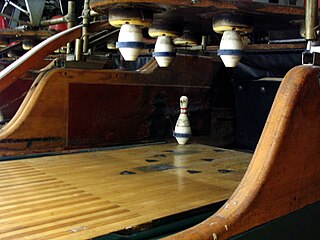
Five-pin bowling is a bowling variant which is played in Canada, where many bowling alleys offer it, either alone or in combination with ten-pin bowling. It was devised around 1909 by Thomas F. Ryan in Toronto, Ontario, at his Toronto Bowling Club, in response to customers who complained that the ten-pin game was too strenuous. He cut five tenpins down to about 75% of their size, and used hand-sized hard rubber balls, thus inventing the original version of five-pin bowling.

Ten-pin bowling is a type of bowling in which a bowler rolls a bowling ball down a wood or synthetic lane toward ten pins positioned evenly in four rows in an equilateral triangle. The objective is to knock down all ten pins on the first roll of the ball, or failing that, on the second roll.

Skittles is a historical lawn game and target sport of European origin, from which the modern sport of nine-pin bowling is descended. In regions of the United Kingdom and Ireland the game remains as a popular indoor pub game.

Candlepin bowling is a variation of bowling that is played primarily in the Canadian Maritime provinces and the New England region of the United States. It is played with a handheld-sized ball and tall, narrow pins that resemble candles, hence the name.

Duckpin bowling is a variation of the sport of bowling.
A perfect game is the highest score possible in a game of bowling, achieved by scoring a strike in every frame. In bowling games that use 10 pins, such as ten-pin bowling, candlepin bowling, and duckpin bowling, the highest possible score is 300, achieved by bowling 12 strikes in a row in a traditional single game: one strike in each of the first nine frames, and three more in the tenth frame.
Bowling for Dollars is a television game show on which people could play the sport of bowling to win cash and sometimes prizes based on how well they bowled.

In bowling, a pinsetter or pinspotter is an automated mechanical device that sets bowling pins back in their original positions, returns bowling balls to the front of the alley, and clears fallen pins on the pin deck. Prior to the machine's invention, pinsetters were boys or young men hired at bowling alleys to manually reset pins and returned balls to the player. The first mechanical pinsetter was invented by Gottfried (Fred) Schmidt, who sold the patent in 1941 to AMF. Pinsetting machines have largely done away with pinsetting as a manual profession, although a small number of bowling alleys still uses human pinsetters. While humans usually no longer set the pins, a pinchaser is often stationed near the equipment to ensure it is clean and working properly, and to clear minor jams.

Bowling pins are the target of the bowling ball in various bowling games including tenpins, five-pins, duckpins and candlepins.

The Flintstones is a pinball game released by Williams in 1994 and based on the movie of the same name which is based on 1960–1966 animated television series of the same name. This machine is not to be confused with another pinball machine, a redemption game, based on the TV series and also released in 1994, manufactured by Innovative Concepts in Entertainment (ICE).

In bowling, a strike means that all of the pins have been knocked down on the first ball roll of a frame. On a bowling scoresheet, a strike is marked by an "X".
Bowlliards is a pool game often used as a training drill. The game borrows aspects of ten-pin bowling, hence the name. The game is divided into ten frames where a player gets a maximum of two innings to pocket ten balls.

Basque bowls, is one of the few Basque rural sports which do not originate in an activity related to rural or marine work. It has a number of other names too and is played in a bolatoki or bolaleku "bowls place" which often consists of a playing area in the open, an open sided structure with a low roof or a playing area located inside a colonnaded hallway.

Nine-pin bowling is a bowling game played primarily in Europe. European championships are held each year. In Europe overall, there are some 130,000 players. Nine-pin bowling lanes are mostly found in Austria, Czech Republic, Slovakia, Belgium, Germany, Luxembourg, the Netherlands, Estonia, Switzerland, Serbia, Slovenia, Croatia, Poland, North Macedonia, Hungary, Brazil and Liechtenstein.

Bowling is a target sport and recreational activity in which a player rolls a ball toward pins or another target. The term bowling usually refers to pin bowling, though in the United Kingdom and Commonwealth countries, bowling could also refer to target bowling, such as lawn bowls.

Ground billiards is a modern term for a family of medieval European lawn games, the original names of which are mostly unknown, played with a long-handled mallet, wooden balls, a hoop, and an upright skittle or pin. The game, which cue-sports historians have called "the original game of billiards", developed into a variety of modern outdoor and indoor games and sports such as croquet, pool, snooker, and carom billiards. Its relationship to games played on larger fields, such as hockey, golf, and bat-and-ball games, is more speculative. As a broader classification, the term is sometimes applied to games dating back to classical antiquity that are attested via difficult-to-interpret ancient artworks and rare surviving gaming artifacts.

Animaniacs: Ten Pin Alley is a bowling video game released for the PlayStation in 1998. It is based on the 1996 video game Ten Pin Alley and, in turn, the animated television series of the same name, on the same system. A Nintendo 64 version was planned, but was cancelled because of the limitations of the N64 texture cache.
Bowling Solitaire is a patience or solitaire card game that uses a single deck standard playing cards to simulate a round of ten-pin bowling.












